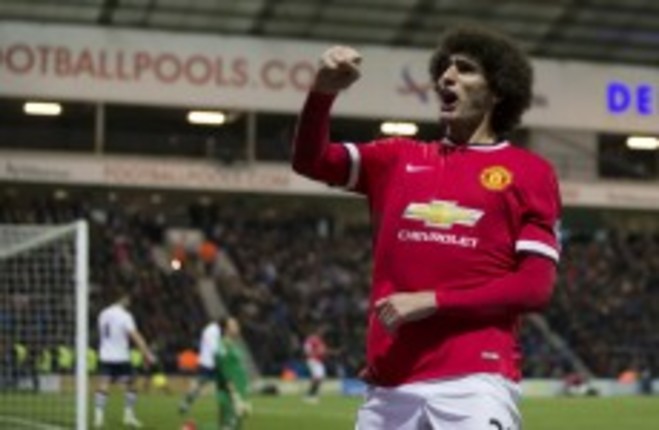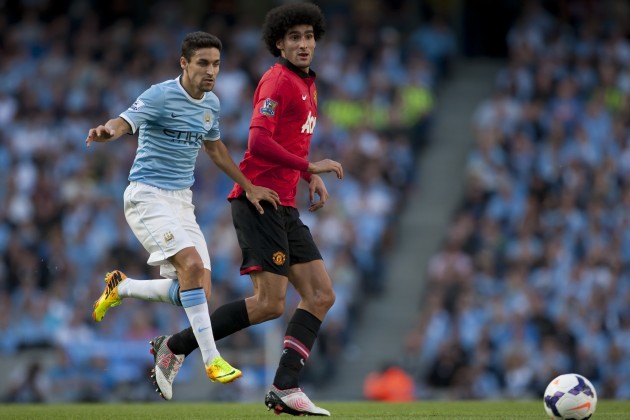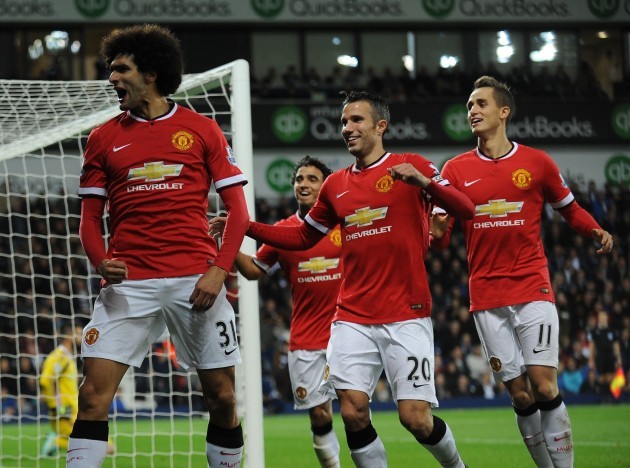Updated at 06.30
MAROUANE FELLAINI’S FIRST Manchester derby is best forgotten.
Just a few short weeks after becoming the club’s fourth most-expensive signing, he lined up alongside Michael Carrick in central midfield for his first Premier League start in a red shirt and was completely overpowered, out-thought and out-fought by the opposing duo of Fernandinho and Yaya Toure.
Sergio Aguero scored City’s first after 16 minutes and by the time Samir Nasri grabbed a fourth shortly after the restart, United were in a state of shock, bewildered and bemused by the ease with which Manuel Pellegrini’s side had ripped them to shreds.
Fellaini never really got over it. Deployed in a deeper midfield role by David Moyes throughout the season, the Belgian suffered from an identity crisis. At Everton, he was a second striker, a perpetual handful for defenders because of his unique skill-set: a big, combative presence with a magnificent touch. But he always expressed a preference to play in front of the defence. Shortly before joining United, he said:
What is my best position?’ I think it’s a defensive midfielder, that’s the best one. The manager might like it sometimes when I play up front, because I can cause trouble for the defenders. But for me, my best position is defensive midfield – stopping the opposition and then looking to impose myself on a game. When I play up front, it’s hard. It’s not my position and I find it difficult.”
But Fellaini never got the chance to impose himself last term. Seen by Moyes and his assistant Steve Round as someone who could patrol midfield and use his aggression to break up attacks, Fellaini instead seemed meek and out of his depth. As soon as he arrived at the club, he was under immense pressure to perform but having to figure out a new position, there was an inevitable early struggle. But United’s failure to land any other signing ensured Fellaini never had time to properly bed-in. Coupled with United’s other issues under Moyes and how quickly confidence drained from the players, Fellaini suffered more than most as the solitary fresh face. He was an easy target even when his debut campaign was so relentlessly interrupted because of injury.
There was little wiggle-room. United had signed Fellaini to play in midfield and were forced to stick to their guns. Anyway, with so many high-profile names vying for inclusion in attack, Moyes could hardly shun them in favour of the imposing Belgian. This was United, not Everton and Moyes may have second-guessed his instincts and impulses based on his new, intimidating surroundings.
When Moyes eventually went, it seemed certain that a disillusioned Fellaini would too. Last August, a loan deal to Napoli was on the cards but just when it seemed his United nightmare was over, he injured his ankle and was out for almost two months. That was a game-changing moment.
Another occurred at the Hawthorns last October. United trailed West Brom by a goal to nil when Fellaini replaced Ander Herrera at half-time. Almost immediately, he positioned himself on the edge of the area and expertly controlled a deep left-wing cross on his chest. His second touch flicked the ball around Pocognoli. His third touch lashed a ferocious strike past Boaz Myhill. The celebration said it all. The relief was palpable. It was his first competitive goal for the club.
Before United’s win over Aston Villa last weekend, Louis van Gaal spoke about Fellaini and his attitude throughout the entire season.
I have heard a lot of stories about him but from the first training session he did what I asked. He was open and he wants to perform so I am not surprised. He had an unlucky season because he was injured and ill [this year], but when fit he has always played for me because I was looking for a balance and he can give a lot of balance.”
It makes sense. Following his goal against West Brom, Fellaini enjoyed a prolonged spell in the side, van Gaal having little concern selecting him for high-profile games against Chelsea, Manchester City, Arsenal and Liverpool. He was usually used in a central midfield three and, given the extra body alongside him, was afforded the opportunity to get forward and showcase his other talents.
Under Van Gaal, a firm supporter of flexible players, Fellaini has never been forced to screen the centre-backs. Van Gaal likes Daley Blind’s ability to mop up, safe in the knowledge that he keeps the ball well. In Michael Carrick, he has a deep-lying playmaker, another player who rarely surrenders possession – a calm, composed heartbeat.
Fellaini provides an aggression in his approach, a hustle and bustle. Many, and you’d have to include Moyes in this, think that this equates to being suited to a defensive position, an ability to be dogged and determined. Sir Alex Ferguson felt the same way about Alan Smith when he attempted to re-create him as a replacement for Roy Keane. But you can be aggressive and still prove a formidable attacking presence.
It’s what Van Gaal means when he uses the term ‘balance’. Yes, Fellaini can be a target-man and menace in the penalty area owing to his size and combative nature (like in the FA Cup clash with Arsenal) but he’s shown another side in recent weeks, becoming a crucial element in United’s approach against the better teams because of his ability to be aggressive in the final third.
Against Liverpool, United began superbly. They refused to allow the home side dictate the tempo through their possession game and shut them down in key zones. Juan Mata’s first goal was created by Ander Herrera but it was Fellaini who made a key interception and opened the pitch up with a simple pass inside to the former Athletic Bilbao midfielder.
In a key tactical battle, Fellaini was a hugely important element, dropping deep when required, drifting to the left side to keep Raheem Sterling and Emre Can busy, making runs from deep as United tried to capitalise on the drawbacks of Liverpool’s wing-backs being caught too high up the pitch and helping out his defence when necessary. With Herrera and Carrick supplying the level-heads behind him, Fellaini was afforded the chance to impose himself. Exactly what he’s always wanted to do.
Unsurprisingly, his performance level dropped against Aston Villa. Facing a more traditional and conventional opposition, the game by-passed Fellaini, who relishes the cut and thrust of games. The slower tempo counted against him and he was already off the pitch by the time Wayne Rooney scored United’s second.
Against Manchester City though, he should revel in his renewed responsibility and he may just go a long way to exorcising those derby demons that have haunted him for the last nineteen months.
Originally published at 12.13 on 9 April



